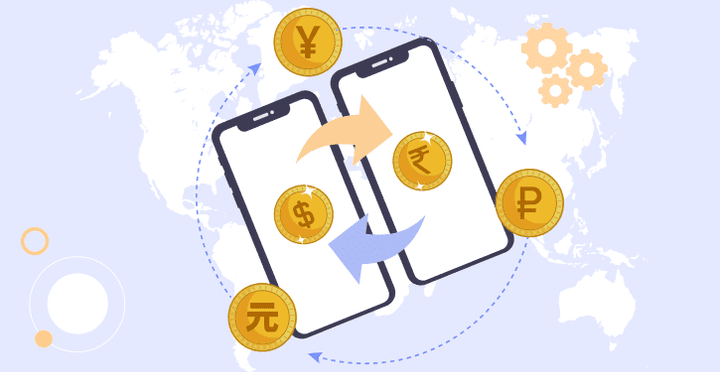For many families that live in the developing countries, the money sent by their migrant relatives is nothing less than a lifeline. One in every nine people globally sustains on these funds sent by the migrant workers. On a larger scale, international remittance has become a prime contributor in the GDP of many Low and Middle Income Countries (LMICs).

Only in 2018, more than 200 million migrant workers sent over $689 billion to their respective countries. Out of the total amount, $529 billion went to developing countries.
The amount sent by the migrants constitutes only 15% of their total earnings. However, the interesting point to note is that the small proportion of migrant’s earnings makes up to almost 60% of his family’s household income.
Global remittance: An expensive affair
There’s no doubt that global remittance has proved to be a lifeline for many families. However, it’s also true that the global remittance services are expensive as they come with a bunch of hidden charges, which both senders and recipients often fail to realize.
According to the World Bank, the average charges levied by the global remittances is approximately 7% of the funds sent. To give you a perspective, that’s more than twice of United Nations Sustainable Development Goal (SDG), which is 3 percent.
This means that a whopping $40 billion would disappear annually in the form of transaction fees and hidden charges for remittances.
But why remittance is such a costly affair?
There many reasons for high costs, one of the reasons is that the banks consider remittance as a high risk sector. Secondly, the international remittance requires multiple credits and debits across accounts that ultimately passes on the money from the sender’s country to the beneficiary that are situated in other countries.
There are many others factors that increases the remittance costs such as
- FX spreads
- Difference between the conversion rate of inter-bank currency and the rate cited by the bank
- Processing fees for each transaction
- Commissions of multiple intermediaries that are involved in the process
Talking about the non-bank remittances, giants like Western Union, MoneyGram, Ria Money Transfer, etc have dominated the industry. These non-bank remittance behemoths form a mammoth network of 1.1 million agents across the globe.
As compared to the banks, these non-bank remittance services have competitive offers. However, the cost involved in building and maintaining the agent networks is high and is usually compensated by levying additional charges on the consumers.
Whether it’s through banks or non-bank remittances, sending money across the border is costly.
If there was a way by which we could’ve reduced this cost then it would have a humongous impact on the migrants’ families.
However, over the years, there seems to be a solution to that, which is FinTech.
FinTech: Making global remittance fast, cost-effective, and accessible
Over the years, there has been a significant growth in some FinTech international money transfer companies. Companies like TransferWise are valuing more than 1 billion US dollar which also started making profits within the first six years of its beginning.
Not only this, many other companies have also attracted the attention of venture capitalists. TransferWise has managed to raise a mammoth amount of over $390 million in total of seven rounds.
Whereas, WorldRemit, which is a UK-based company has raised an impressive sum of more than $230 million in nine funding rounds. Similarly, InstaRem, which is a Singapore based company has raised approx. $18 million in its seed funding in only two subsequent attempts.
The advent of these and other several FinTech players has certainly changed the landscape of international remittance. People around the globe are choosing FinTech remittance services over any other.
But how did it actually happen? What were the factors that made FinTech so popular.
Let’s see.
Faster than banks
One of the biggest advantages of using FinTech solutions for international remittance is speed. Where a bank can take up to a few days to transfer money, the FinTech applications take considerably shorter time. In addition, it also enables the users to choose the option of express delivery method that further speeds up the transfer process.
Ending bank’s remittance monopoly
Until the very last decade of the 20th century, people were completely dependent on either banks or expensive forex brokers to transfer their money cross-borders. The advent of FinTech has totally ended the bank’s and forex broker’s monopoly over international remittance. Now, with FinTech, consumers can easily send their money abroad.
Read More: FinTech and its effect on banking.
Higher exchange rates
Before the introduction of FinTech, getting better exchange rates was a challenge. Even the small and mid-sized enterprises didn’t get any favourable exchange rate. However, things took a complete turnaround as FinTech payment solutions started providing competitive exchange rates which were quite close to the existing market rates.
Lower cost
Many remittance FinTech companies process remittance requests for free for few selected regions. Not only that, FinTech also refrains from charging extra fees such as amendment charges, cancellation fee, and other hidden charges. Thus, resulting in an overall lower cost.
Multiple ways to send money
FinTech has played a major role in simplifying the process of transferring money abroad. The international remittance solutions allow the consumer to send money in a variety of ways such as:
- Making cross-border fund transfer via their internet enabled smartphone.
- Making international remittance over phone by speaking to the currency brokers.
- Making transfer by simply handing over the cash at the physical locations.
Multiple payment modes
International remittance app powered by FinTech offers its consumers with a plethora of payment modes. Among which making payments through bank account transfer is considered to be the most cost effective. However, there are few obstructions in that mode of transfer.
One, not all banks accept credit and debit cards. Second, those who do levy additional charges for card payments. Apart from the bank transfer, other options are Google Pay, Apple Pay, Venmo, Square Cash, iDEAL, ACH, SOFORT, etc.
Small or no transfer fees
Apart from exchange rate, transfer fees also affect the cost effectiveness of a transfer. Transfer fee is the amount that a sender needs to pay. Generally, banks kept a high transfer fee. However, Digital Money Transfer Software powered by FinTech started to relieve their users by imposing little or no transfer fee depending on the region from where they hail from. Remittance FinTech companies like OFX and Currencies Direct don’t take any transfer fee for the residents of most countries.
Perks of Big Data
FinTech companies can use Big Data to establish stronger relationships with their customers. Companies like Xoom has already got experts that analyse the Big Data generated in each transaction.
In 2011, it detected an anomaly which wouldn’t have been possible to detect without the Big Data. It was the case of a criminal group that was trying to defraud the company by bombarding a high number of Discover Card transactions that were based in New Jersey.
Apart from that, Big Data also provides vital insights regarding devices, frequency of transfers, locations, timestamps, and many more.
Hedging tools
Early on Hedging tools such as forward contracts and market orders were difficult to access for individuals as well as for the small and medium sized enterprises. However, with FinTech remittance start-ups and companies, these tools are available to them. Companies namely Currencies Direct, WorldFirst, OFX, and TorFX provides these tools.
Hedging tools are effective as they have the ability to make the most out of fluctuations taking place in the exchange rates. In addition to that, there are some FinTech companies, that also allows their customers to set up scheduled transfers.
Multicurrency accounts
FinTech companies offer multi currency account in which the user gets account details from various countries. In this account, the users don’t have to worry about the exchange rates as they receive payments in the matching currencies.
Many FinTech companies such as OFX, WorldFirst, and TransferWise offer this service that are designed specifically to serve the freelancers, online sellers, small to mid-sized enterprises and more.
Cash transfer with FinTech
When it comes to remittance involving cash pickups, the renowned names like MoneyGram and Western Union are still ahead. However, FinTech is slowly progressing in this segment too. You won’t find many FinTech names in this segment apart from the few ones like Ria, Azimo, and WorldRemit.
Enhanced transparency
FinTech international payments solution has set a new benchmark for the transparency in the remittance industry. It’s due to the fact that all the people whether they are sending or receiving funds are kept in the loop and are provided with real-time updates. Apart from ensuring the transparency, the solution also ensures to maintain the top-notch security by carrying out transactions via a secure tunnel.
Conclusion
FinTech has been a game changer for all the people involved in international remittance. It has redefined the way people make cross-border money transfers. Leveraging cutting-edge technologies, FinTech has made international remittance cost-effective, secure, and swift.
International remittance, which was once seen as a costly service that was available to only a small portion of the population has now been made available to everyone at little or no price all thanks to the FinTech.
When it comes to remittance, people usually think of migrants sending money to support their families. But it is so much more than that. Remittance also means better healthcare, education, and even a better standard of living.
As the time progresses FinTech’s role in the international remittance will increase as it will keep going on, making transferring of money across borders nothing but a standard practice.



